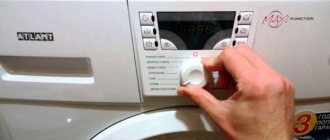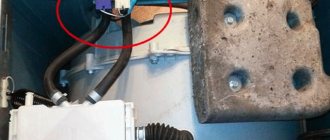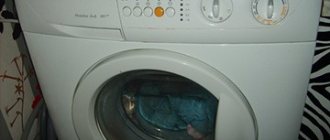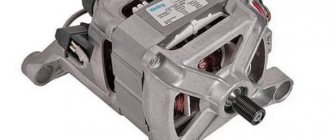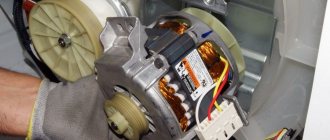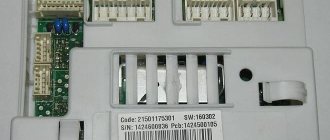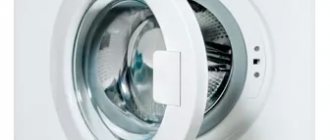Filters in the water supply and drainage system: type, purpose, principle of operation
In any washing machine, filter elements are installed at at least two key points: at the inlet and at the outlet. Thus, their main types are distinguished:
- Jellied. Designed for mechanical purification of supplied water from small suspended matter, sand and other particles, such as rust.
- Drain (drainage). This washing machine filter is designed to protect the drain pump impeller from damage while removing water after rinsing. As a rule, it is capable of catching fairly large foreign objects, such as buttons or small coins.
Note! The described filters provide only rough mechanical cleaning and do not in any way affect the composition of the water. Therefore, additional fine cleaning systems should be used to soften or remove harmful impurities.
Causes of blockages
The most common cause of clogging of the inlet filter is the formation of a dirt plug or limescale crust on the surface of the mesh. This is usually not a problem, since cleaning the filter in the washing machine can be done quite quickly. However, this must be done regularly, otherwise both the pump and the more expensive circulation pump may fail.
When clogged, a dirt plug forms on the filter.
Most drain filter clogs can be caused by the following:
- Extremely hard water. Excess salts can accumulate not only on the heating element and the walls of the tank.
- Frequent washing of fur or down items.
- Poor preparation of clothes before washing. Small items from pockets can get into the filter and clog it.
- Presence of pets. Wool or feathers settle on the surface of clothing in fairly large quantities. Naturally, all this ends up in the drum.
The causes of blockages can be different.
Damage to the oil seal and bearings
The appearance of water during the spin cycle may indicate damage to the tank seal. The presence of a leak of this kind is indicated by drips on the tank leading down from the bearings. In this case, the bearings and oil seal need to be replaced.
Similar problems can also be indicated by the appearance of water from the rear wall of the washing machine. To check the bearings for serviceability, you need to spin the empty drum of the washing machine by hand. If you hear extraneous noises or a slight grinding noise when it moves, most likely the seal or bearings have failed. In this case, the car must be repaired immediately, otherwise water may get on the engine.
Clogged washing machine filter: typical symptoms
The main sign of poor permeability of the inlet filter is either the complete absence of supplied water or a noticeable decrease in pressure. In this case, the sound of the operating pump may change to a drawn-out, mournful tone, which indicates the impossibility of supplying the required volume of water at the calculated speed for the selected program.
The main sign of a blockage is a lack of water supply.
Typical signs of a clogged drain filter are:
- Significant increase in rinsing time: dirty water is drained slowly.
- The door remains locked for a long time after the wash is completed.
- Turning off the machine when selecting the “spin only” option.
- Refusal to rinse.
A blockage can also lead to bigger problems.
Where is the filter located in the washing machine? Do-it-yourself dismantling
The location of the inlet filter in most modern washing machines is the same - on the back panel, at the top. To remove it you will need to turn off the water and unscrew the nut securing the inlet pipe. Access to the filter can be difficult due to accumulated dirt, so sometimes you have to remove it with long-nose pliers. In this case, you need to work carefully, pulling it out with rotational movements from side to side, without excessive force.
Dismantling the drain filter is no more difficult, but has a number of nuances. As a rule, it is located on the front panel at the bottom of the washing machine, behind a decorative plug. Depending on the model, the filter may be on the left or right side, usually on the right. However, there are quite exotic solutions when the drain filter is located inside the drum. Fortunately, they are quite rare.
Typically the drain filter is located on the bottom of the front panel.
It doesn’t matter whether the washing machine filter is cleaned by Samsung, Indesit or Bosch, the typical sequence for removing it generally looks the same:
- Disconnect the machine from the electrical network.
- Turn off the water supply tap.
- Open the decorative hatch. Some manufacturers prefer a solution with a completely folding plinth at the bottom. In any case, the filter cover is located behind such plugs.
- Prepare a container or thick cloth to drain the remaining water.
Even in a non-working machine, there is always a minimum amount of water - this is explained by the specifics of the drain system. When you unscrew the lid, the water will begin to flow out, so you will have to remove it quickly. Some washing machine models have a special hose designed for this purpose. It may be located next to the snail neck, which houses the drainage filter of the washing machine. - Unscrew it. It is necessary to rotate counterclockwise. It is necessary to regulate the applied force so as not to break the plastic fastener or strip the thread.
- Pull out the filter. You will have to act carefully, since fallen objects and accumulated dirt can block free movement. If this is the case, then you should try to break the formed plug by rotating the filter from side to side.
Is it worth repairing an old car?
After detecting a breakdown and approximate assessment of the financial damage, most users are faced with the question of whether it is advisable to carry out repair work. And this question is quite logical. Most service centers charge serious money for their services. This is especially true in Moscow and St. Petersburg, where even the simplest repairs can cost a very significant amount.
Many users are thinking about purchasing a new car or calling a private technician who does “black work.” Such “specialists” do not pay taxes, do not provide a guarantee, but they perform repairs much faster and cheaper than real service engineers. On the one hand, such savings may seem reasonable, but upon closer examination it is better to refuse calling a private trader. The low price is achieved through the installation of non-original spare parts, which often do not even have markings. Yes, they will work for a while, but in a few months the problem may appear again, and under warranty such a technician will not come back.
How to clean the filter in a washing machine?
In most cases, filter maintenance comes down to regular rinsing under running water. Unless when cleaning the drainage, it is advisable to check the condition of the inside of the drainage system, accessible from the front panel.
Before washing, the filter must be cleaned of large contaminants.
Fill filter
Structurally, it is a plastic cylinder with a fine mesh at the end. Cleaning consists of thoroughly washing away sand and dirt accumulated in the cells and under the rim. For difficult areas, you can use a regular toothbrush.
If washing does not give positive results or the mesh has visible damage, the filter must be replaced. In addition, you need to remember about the rubber gasket that prevents water from leaking from under the inlet pipe - it can be lost or damaged during cleaning.
Drain filter
In small details, the design may vary greatly from manufacturer to manufacturer, although the basic concept remains the same. First of all, you need to clean the filter from large deposits and debris, and then rinse thoroughly with warm water. Carry out mechanical processing as carefully as possible so as not to damage the rubber seal on the lid!
The drain filter is carefully washed with warm water.
In addition to the filter itself, cleaning is also required in the nest - where the drainage filter is located in the washing machine. To do this, you can illuminate the intake neck with a flashlight to check it for the presence of accumulated dirt or lime deposits. As for scale, if the filter is heavily coated with deposits, it can be removed by immersing it in a citric acid solution for a while. In this case, you should take care of the rubber gasket.
The filter housing also needs cleaning.
Important! As a rule, the filter socket also provides access to the drain pump impeller. It makes sense to check it for stuck debris or other small items.
There may also be debris in the pump.
Damage to loading hatch
First of all, you should pay attention to the location of the puddle. So, if water collects closer to the front side of the machine and its amount increases during the spin cycle, the hatch seal is most likely damaged. Punctures or cuts can be caused by sharp edges of accessories on clothing or items forgotten in pockets. Over time, under the influence of water and detergents, any seal can lose its properties and allow water to pass through. If it is damaged, the sealing rubber must be replaced - it is useless to seal the cuff, since it can shrink and stretch during washing.
Sometimes leaks are also caused by a washing machine hatch that does not close tightly.
The integrity of the cuff can be damaged by exposure to aggressive substances contained in detergents or by fungal infection. You can replace the cuff yourself. Its outer part is slightly recessed into the hole in the front wall and is fixed there using a wire or plastic clamp.
It is easier to put on a clamp with an adjusting screw - after putting it in place, the clamp is gradually tightened and the screw is tightened in a certain position. After installation, the cuff should be checked for fresh leaks.
The plastic clamp can be removed by pulling towards the area where the latches meet. To remove the wire clamp, you need to pry the spring or unscrew the fixing screw. The next step is to locate the installation mark on the cuff. It is necessary to determine the fixed position of the cuff according to the tank. If there is no such mark, use a marker to mark where the cuff is located to the tank. The mounting edges must be cleaned of dirt and deposits and thoroughly lubricated with soapy water. The more slippery the surface, the easier it will be to install the new cuff. Before installation, you need to align the cuff with the applied installation marks. The cuff is taken from the inside and placed in a circle on the edge of the tank. When the replacement is completed, you need to examine the perimeter of the ring with your fingers to check the tightness of the cuff with the edge. The next step is to put on the outer and inner clamps. To install the spring clamp, you need to use a screwdriver, with which it is fixed in the initial position.
How to clean a washing machine filter: popular means
Cleaning the internal parts at home makes sense only if it is carried out regularly. Usually, either household chemicals from a hardware store or “folk” methods are used for this.
Household chemicals
Of the available chemicals, the most effective is the popular bleach “Belizna”. To carry out cleaning, you need to pour it into the powder compartment and run the “idle” program with the longest execution time. In this case, the temperature should also be set to maximum.
Then you will need to wait about half an hour and put the machine in pause mode, in which it should stand for an hour or two, after which you can continue washing. At the end, it is advisable to carry out an additional rinse cycle.
The most accessible remedy is Whiteness.
Copper sulfate is sometimes used as an alternative. Before cleaning the filter, vitriol is diluted in cold water (about two tablespoons per liter). With the resulting solution you need to wipe all the internal parts, including the “nest”, and then start the wash without laundry, but with washing powder. When finished, it is recommended to run an additional rinse, then wipe the internal parts dry.
Treating washing machine parts with copper sulfate is effective.
Folk remedies
Here everything is as usual: citric acid or vinegar. Pour the acid (about 100 g) into the powder container and run an “empty” wash cycle at maximum temperature. You should be careful not to overdo the dosage, otherwise you may damage the rubber seals. At the end of the cycle, turn on the rinse again.
You can add citric acid to the powder compartment and run an empty cycle at maximum temperature.
Cleaning with vinegar follows the same principle. Two glasses of table vinegar should be poured into the powder receiving tray, and then run a long-term wash program at a temperature of 90 degrees. After ten to fifteen minutes, pause the machine and let it sit for about an hour. Then, after completing the program, wipe everything dry.
Table vinegar also effectively fights stains.
About Maunfeld
In addition to caring about reliability and manufacturing quality, the company's engineers pay a lot of attention to introducing innovative functions and creating a user-friendly interface that greatly simplifies working with the device and frees up free time that can be spent on your favorite activity. It is also worth noting that “Mounfield” household appliances are produced with the assistance of the world’s best designers, who analyze the wishes of users, current trends, and create not only functional, but also visually attractive devices. Thanks to this symbiosis of quality, reliability and unique style, Maunfeld appliances have become one of the most successful manufacturers of household appliances in the world.
After cleaning, the washing machine filter leaks: causes and solutions
The main problems that may arise when cleaning the drainage system are non-compliance with installation and dismantling rules. They usually appear as a result of:
- Incorrect filter installation. A misaligned or loosely tightened lid can cause water that escapes under pressure to leak out. It is necessary to re-disassemble and reassemble the drainage.
- Worn or damaged gasket. The filter cover is equipped with a special rubber seal, located at its base and designed to prevent leaks. If you do not clean it carefully or due to other factors, it may become unusable. The problem is solved by replacing the sealing gasket.
- Broken thread or damaged filter housing. Excessive force during disassembly or installation are typical causes of this type of malfunction. You may need to completely replace the failed unit.
If you assemble the filter incorrectly, it may start to leak.
Damage to the rubber cuff
If water is running down the front of the machine, make sure it is coming from under the door and not from the powder receptacle. Water can ooze from the dispenser tray in small streams, go around the control panel, approach the hatch and create the impression that this is where the leak has appeared.
But when you are absolutely sure that water is leaking under the door, it is recommended to check the integrity of the cuff, since a leak may occur due to severe wear of the sealing element. When closed, the washing machine system should be sealed, but if damage appears on the cuff, this condition will not be met.
By the way, the cuff does not necessarily have to have cracks or tears. It may become wavy or too stiff, which can also cause water leakage.
You can replace the cuff yourself or invite an experienced specialist to do this work.
Sometimes water leaks are caused by small foreign objects stuck between the rubber seal and the glass of the loading hatch door, preventing a tight connection. In the case where the seal is quite flexible and looks normal, simply clean the rubber itself and all surfaces of the hatch in contact with it, removing lint, small particles of fabric, and washing powder residues.
Should I ignore filter cleaning?
In short, no, it’s not worth it! Periodic cleaning of the filter of a washing machine, be it Samsung, Bosch or Indesit, is a prerequisite for its trouble-free operation. Ignoring preventive maintenance of the supply and drain systems can lead to deterioration of the washing process, and in particularly advanced cases, to failure of the machine.
The filter needs to be cleaned regularly.
Often, it is failure to comply with this requirement that causes the appearance of a persistent unpleasant odor from the drum, which remains on the washed laundry. In addition, this is a common cause of deterioration or even complete cessation of the draining process, which, under certain circumstances, leads to failure of the drain pump.
Failure to clean the filter may result in failure of the drainage system.
For what reasons do leaks occur?
When the garbage filter leaks, water pours out from under the washing machine. However, before solving the problem, you need to make sure that the drain filter is leaking. After all, any part can leak: a pipe, a tank, a drain pump. Wipe the suspected leak with a dry towel or napkin and see if the filter gets wet over time. If yes, let's move on.
What is the SM cleaning element? It resembles a cork and is inserted into the snail of the washing machine. The snail, in turn, is connected to a channel for discharging water used during washing and a channel for pumping out water. Thus, if the filter is not sealed, water after washing will come out of the tank and spill from below. There are usually two reasons why the filter leaks.
- Incorrectly screwed in plug. If the filter is not put in place correctly, there is a high chance that there will be a gap through which water will leak. The same thing can happen if the plug is screwed in loosely.
- The rubber seals are worn out. They are located at the edges of the snail and on the filter itself. They just prevent water from seeping through the cracks. Over time, rubber tends to dry out and wear out, which leads to seal failure and leaks.
Now, knowing the reasons, you can deal with the consequences. Keep in mind that a leak may occur as a result of something completely unpredictable, in which case you will have to contact a specialist. We will consider the algorithm of actions in a standard situation.
Washing machine filter: preventing blockages
To avoid unwanted situations caused by clogged drainage systems, it is recommended to adhere to the following rules:
- Clean the drain filter every six months. The frequency depends on the number of cycles.
- It is not recommended to leave washed items in the drum for a long time. This can lead to fungus and plaque forming inside the machine.
- Use detergent without additional additives.
- Periodically clean the drainage system with citric acid or vinegar.
- Observe safety precautions when assembling or disassembling filtration units.
- Keeping your washing machine tidy isn't just about the outside.
Your washing machine needs to be maintained and kept clean regularly.
Based on the above, regular prevention of drain filter blockages is one of the ways to extend the life of the washing machine. Such a simple operation as cleaning the filter in a washing machine allows you to get rid of possible problems in the future and ensure high-quality washing for many years.
Dispenser clogged
If it is discovered that water is leaking from the machine at the very beginning of the wash, during the water collection stage, this may be caused by damage to the detergent tray or hoses located near it.
During operation of the machine, the tray tends to become clogged with washing powder, which is not completely washed out during washing. Over time, the holes through which water should penetrate into the tray become clogged, and it does not have time to wash off the powder and get further into the tank. Excess water in such a situation flows out along the front wall.
When using a washing machine for a long time, hard tap water can deposit limescale and clog the holes through which water is supplied to the tray. In this case, the stream under pressure is forced to change its direction and flow past the tray.
Water leakage can also be caused by a broken inlet valve or too much pressure in the water supply system. To remove the blockage, you need to remove the dispenser from the hopper and thoroughly rinse the parts. A mandatory measure is to inspect the bunker drain neck to see if there is a foreign object that could obstruct the flow of water. In the case when reducing the pressure (to do this, partially turn off the tap) and cleaning the dispenser do not help, you should replace the inlet valve, which, if broken, can increase the pressure during rinsing. You can also see how to clean a washing machine with citric acid.

